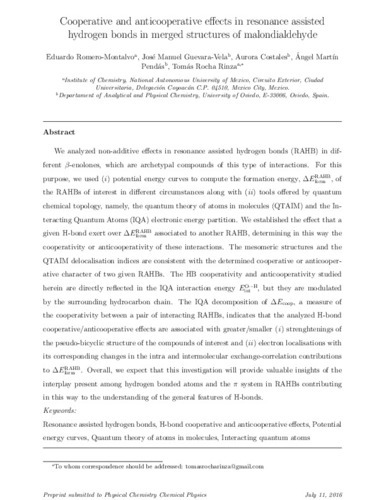Cooperative and anticooperative effects in resonance assisted hydrogen bonds in merged structures of malondialdehyde
Palabra(s) clave:
Resonance assisted hydrogen bonds
Cooperative and anticooperative effects
Fecha de publicación:
Editorial:
Royal Society of Chemistry
Versión del editor:
Citación:
Descripción física:
Resumen:
We analyzed non-additive effects in resonance assisted hydrogen bonds (RAHBs) in different b-enolones, which are archetypal compounds of these types of interactions. For this purpose, we used (i) potential energy curves to compute the formation energy, DERAHB form , of the RAHBs of interest in different circumstances along with (ii) tools offered by quantum chemical topology, namely, the Quantum Theory of Atoms In Molecules (QTAIM) and the Interacting Quantum Atoms (IQA) electronic energy partition. We established the effect that a given H-bond exerts over DERAHB form associated with another RAHB, determining in this way the cooperativity or the anticooperativity of these interactions. The mesomeric structures and the QTAIM delocalisation indices are consistent with the determined cooperative or anticooperative character of two given RAHBs. The HB cooperativity and anticooperativity studied herein are directly reflected in the IQA interaction energy EOH int , but they are modulated by the surrounding hydrocarbon chain. The IQA decomposition of DEcoop, a measure of the cooperativity between a pair of interacting RAHBs, indicates that the analyzed H-bond cooperative/anticooperative effects are associated with greater/smaller (i) strengthening of the pseudo-bicyclic structure of the compounds of interest and (ii) electron localisations with its corresponding changes in the intra and intermolecular exchange–correlation contributions to DERAHB form . Overall, we expect that this investigation will provide valuable insights into the interplay among hydrogen bonded atoms and the p system in RAHBs contributing in this way to the understanding of the general features of H-bonds. 1
We analyzed non-additive effects in resonance assisted hydrogen bonds (RAHBs) in different b-enolones, which are archetypal compounds of these types of interactions. For this purpose, we used (i) potential energy curves to compute the formation energy, DERAHB form , of the RAHBs of interest in different circumstances along with (ii) tools offered by quantum chemical topology, namely, the Quantum Theory of Atoms In Molecules (QTAIM) and the Interacting Quantum Atoms (IQA) electronic energy partition. We established the effect that a given H-bond exerts over DERAHB form associated with another RAHB, determining in this way the cooperativity or the anticooperativity of these interactions. The mesomeric structures and the QTAIM delocalisation indices are consistent with the determined cooperative or anticooperative character of two given RAHBs. The HB cooperativity and anticooperativity studied herein are directly reflected in the IQA interaction energy EOH int , but they are modulated by the surrounding hydrocarbon chain. The IQA decomposition of DEcoop, a measure of the cooperativity between a pair of interacting RAHBs, indicates that the analyzed H-bond cooperative/anticooperative effects are associated with greater/smaller (i) strengthening of the pseudo-bicyclic structure of the compounds of interest and (ii) electron localisations with its corresponding changes in the intra and intermolecular exchange–correlation contributions to DERAHB form . Overall, we expect that this investigation will provide valuable insights into the interplay among hydrogen bonded atoms and the p system in RAHBs contributing in this way to the understanding of the general features of H-bonds. 1
DOI:
Patrocinado por:
DGAPA/UNAM (project PAPIIT IN209715), CONACyT/México (grant 253776, and scholarships 308773 and 381482) and the Spanish government (grant CTQ-2015-65790-P) as well as computer time from DGTIC/UNAM (project SC16-1-IG-99).
Colecciones
- Artículos [36390]
- Investigaciones y Documentos OpenAIRE [8027]
- Química Física y Analítica [612]
Ficheros en el ítem





